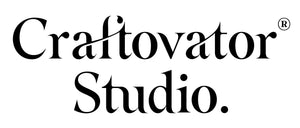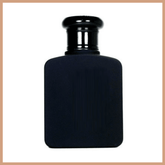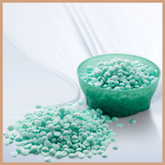How to Make a Soap Sponge - Reduce Plastic the Easy Way
If you're wondering what on earth a soap sponge is, the clue is in the name! A soap sponge is basically a soap infused sponge. So just like a body wash on a flannel or a shower gel on a shower puff, these liquid-free and plastic reducing sponges not only create a more efficient bathing experience, they are incredibly easy to make yourself too.

Ready to try making a soap sponge yourself? Our tutorial will show you how easy it is and then read on to find out more ways to customise your own soap sponges using melt and pour soap base, colourants and fragrances!
Please note: Our tutorial is designed for personal use only. You will need to follow all legal responsibilities before selling any products that come into contact with skin.
See our Melt & Pour Soap Assessment (which covers soap sponges too) to purchase an assessment and our blog post on Assessments & CPSR - How to Sell Bath & Beauty Products in the UK for more information.
Difficulty Level: Beginner
Makes: 2 Sponges
Ingredients

- 200g Aloe Vera Melt & Pour Base
- 1g Sparkle White Mica
- 4g Spa Day Fragrance Oil
- Bath sponge
Equipment you will need

- Microwave or double boiler/saucepan
- Kitchen weighing scales
- Heat proof jug
- Bowl
- Sharp Knife
- Spatula
- Isopropyl alcohol or Rubbing alcohol in a spray bottle
- Baking paper or parchment paper
- Thermometer (optional)
- Clingfilm (optional)
Step 1 - Cut and weigh the melt and pour base

Place your jug/bowl onto the scales and zero out the counter. Now cut your melt and pour base into small uniform cubes and weigh out 200g into the jug.
Step 2 - Melt the Base

Cover your jug with clingfilm to help keep in the moisture whilst heating. Heat your base on 30 second bursts in the microwave until it's fully melted. You can stir between bursts to make sure the clumps are all separated.
If you'd prefer not to use a microwave, the soap base can be heated in a glass bowl over the top of a saucepan of boiling water. This is called the double boiler method.

Once fully melted, spray a little rubbing alcohol to disperse the bubbles and replace the clingfilm over the top which will help prevent a skin from forming on the melted soap.
Melted soap can reach temperatures of about 65-70 degrees C so please be careful not to splash it on yourself. You don't want to overheat your soap base either so try to ensure your soap base doesn't exceed 68-70 degrees C.
Step 3 - Adding the colourants

Measure around 1g of mica powder and add it to your base.

Mix until the mica is fully dispersed, around 1-2 minutes.
Step 4 - Add the fragrance oil

The melted base should be no more than 60 degrees C now and is the ideal temperature to add your scent. If you have a skin forming or the temperature is much lower than suggested, then another 10-15 second burst in the microwave can be done before adding the fragrance oil to bring it back up to the correct temperature.

Add the fragrance oil and gently stir for a minute or two. If bubbles form whilst stirring, give it a spray with the rubbing alcohol.
Step 5 - Dampen your sponge with the alcohol spray

Spray the sponge with the alcohol until it feels damp but not wet.
Step 6 - Transfer the soap into the bowl

Take your jug of soap and transfer into the bowl. If the temperature of the soap has dropped and a skin is forming, you can give it a quick blast in the microwave to fully melt the skin.

Place your sponge into the soap base. Take your spatula and push down onto the sponge to allow the air inside to be displaced. This allows the sponge to soak in the soap base on release. Repeat this while turning the sponge to allow the soap to soak in evenly.
Step 7 - Leave to cool and dry

Once you have completely soaked the sponge with the soap base, place the sponge onto your baking/parchment paper and leave to cool and dry overnight.
The following day, your soap sponge will be ready for use!
What are the benefits of using a soap sponge?

There are so many reasons why you might want to try this project if you've never created a soap sponge before but here are just a few of the benefits of using soap sponges:
- Reduces the need for plastics used in the packaging of body washes and shower gels
- Exfoliates to remove dry skin
- Exfoliates to remove fake tan
- Leaves your skin feeling refreshed and smoothed
- Liquid free so perfect for holiday
- Can last well over a month at a time
- When your sponge is finished, you can use it to clean the bathroom!
As well as all the benefits listed above this has also got to be one of the easiest Melt and Pour Soap projects you can do at home!
Which Melt and Pour soap base should I use for a soap sponge?
For our Spa Day scented soap sponge tutorial, we have chosen the Aloe Vera Melt & Pour Base. We choose this base, not only for its excellent moisturising properties, but because it produces fantastic foaming and lather. Happily, our tutorial is completely customisable and many of the bases we carry would be suitable for this project.
With such a vast range of melt and pour soap bases available, you may be asking, "Which one is the best?" There is no "right" answer here, as with so many different bases available, you'll find each one has their own unique properties so, just choose what appeals to you.
Of course, one important choice you may want to take into consideration is whether to use a clear transparent base or a white base. Using a transparent base will allow the colour of the original sponge to fully show through. Colouring your soap will give you a more brightly coloured soap sponge.
The white base (sometimes referred to as 'opaque') contains titanium dioxide. This base will give you a solid white look or you can use colour additions to give classic pastel colouring.
How Much Fragrance Oil Can I Use For My Soap Sponge?
You are able to scent your soap base with up to 3% of either a fragrance oil or essential oils. What does this mean? When considering the total weight of your finished product, you want to ensure that no more than 3% of that total weight is made up of your fragrance oils.
For instance, if we are using 200g of soap base for our sponge, 3% of the total weight would be 6g of fragrance oil (200g x 0.03 = 6g). So, you’ll always want to measure your fragrance oils in weight, rather than in millilitres, which is a volume measurement. Oils will often differ in their viscosity (meaning some are thicker and some are thinner) so even at the same volume, you will find they will be different weights. To account for this difference and to make things easier, all your ingredients should be using the same unit of measure - in this case, grams.
Can I Use Any Fragrance Oil with My Soap Sponge?
One important aspect of safety when using any kind of fragrance or essential oil is to make sure the oil you’ve chosen is skin safe. Click the link that says ‘IFRA 49th AMENDMENT’ on the fragrance oil product listing to download the document.
Then, check the heading that says, "Certificate of Conformity" and scroll to Category 9. If the IFRA documents states that the safe usage is 3% or higher, then you can use up to the full 3%. However, even if the IFRA document gives a percentage of more than 3%, we would still advise never using more than 3% in your soap sponges.
In melt and pour soap, more often than not, 2% will be sufficient. So, for our tutorial on making our scented soap sponge, you'll see we used 2% of Spa Day Fragrance Oil.
Which colourants can I use in a soap sponge?
Experimenting and being creative with colourants is so much fun. For melt and pour soap, we recommend using mica powders or water-soluble dyes but you can choose any colour you wish when making your soap.
For our Spa Day scented soap sponge tutorial, we used Sparkle White Mica. We used this Mica because our sponges are multi coloured and we still wanted these colours to show through. If you are using a plain sponge, you can get creative with many different colours.
As you can see, soap sponges are incredibly easy to make! Why not check out our tutorial on How to make a Kiwi and Strawberry Massage Soap Bar using melt & pour soap base next?








18 Comments
Thank you for all the help with the sponge. l also wonted to know if there is a pre printed label for melt and pour if that all you use
Hi I purchased an assessment £124, all I have is steps and a list of what I can use? I also filled in the form 16th May but still haven’t received anything else? So filled form again, it’s an awful lot of money for info I already read on the site? Am I missing something? Many thanks
Joanne ellington
Hi Linda, the assessment will give you all the information you’ll need for your label. For more information on what content you’ll need to create your labels, be sure to see our post here: https://craftovator.co.uk/blogs/academy/assessments-cosmetic-safety-reports-what-you-need-to-know-uk
Hope that helps!
Kimberly – Craftovator
Hi, when you purchase the assessment does it tell you which safety labels are needed etc? Thanks
Hi Germaine,
At this time, the assessment only covers the SLS-Free and WSLS-Free soap bases (these can be mixed as well). We hope to introduce more bases in time but for now, those are the only soap bases available to use within our Melt & Pour assessments.
Hope that helps,
Kimberly – Craftovator
Leave a comment
All blog comments are checked prior to publishing